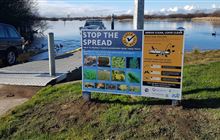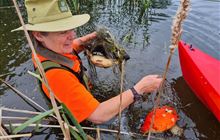Freshwater weeds
Introduction
Freshwater weeds degrade New Zealand's wetlands and waterways. The plants described here pose the most serious threats.With your help we can spot them and stop them before they get established. If you see any of these plants, take note of the location and inform your local DOC office.
Weedbusters, NZ Plant Conservation Network and Ministry of Primary Industries have more information and images to identify the weeds.
African oxygen weed Lagarosiphon major
African oxygen weed is widespread throughout New Zealand and still spreading. Its recent discovery in Lake Waikaremoana is cause for concern and there is an eradication programme currently in place.
Lagarosiphon can be distinguished from other oxygen weeds as its leaves have a distinctive downward curl.
Oxygen weed information and images on Weedbusters website
Alligator weed Alternanthera Philoxeroides
Alligator weed is a sprawling, rooted perennial herb that can grow in both dry terrestrial and aquatic conditions. It may form dense floating mats of vegetation up to 1 m tall which cover the water surface and smother other vegetation.
Alligator weed information and images on Weedbusters website
Arrowhead Sagittaria Platyphylla
Arrowhead is an emergent rhizomatous aquatic plant up to 80 cm tall, that can also produce submerged strap-like leaves. It forms extensive infestations in shallow waterways, where it can seriously restrict water flow, increase sedimentation, and aggravate flooding. Infestations of this plant can also displace native plants in wetland areas.
Arrowhead information and images on NZ Plant Conservation Network website
Clasped pondweed Potamogeton Perfoliatus
Clasped pondweed is a submerged, browny-coloured perennial herb with trailing, leafy stems. It forms dense beds of vegetation that shade out smaller native species, and it can contribute to blockage and flooding. Distinguished from other pondweeds by leaf bases that enclose the stem.
Clasped pondweed information and images on Weedbusters website
Common reed Phragmites Australis
Common reed is a perennial reed grass 2–4 m tall with stiff, wide leaves and hollow stems. It spreads rapidly by stout creeping rhizomes, and is capable of forming large, impenetrable stands along stream margins and in marshes and ditches.
Eelgrass Vallisneria australis
Eelgrass is an attached, submerged aquatic plant. It forms a dense mass of straplike leaves which can grow through the entire water column in standing or flowing waters, displacing native vegetation and impeding drainage.
Eelgrass information and images on NZ Plant Conservation Network website
Egeria Egeria Densa
Egeria (an oxygen weed) is a bottom-rooted, submerged aquatic plant that forms dense beds of vegetation which may reach the water surface. It competes with and displaces native plants, and can also block dams and waterways. Distinguished from other oxygen weeds by conspicuous three-petalled white flowers produced at the surface during summer.
Fringed water lily Nymphoides Peltata
Fringed water lily is a bottom-rooted aquatic plant with long stems that lie just beneath the surface, floating scalloped leaves and distinctive yellow flowers. It has the potential to become an unmanageable aquatic nuisance in waterways, where it can impede drainage, block access, and displace desirable native species.
Fringed water lily information and images on NZ Plant Conservation Network website
Hornwort Ceratophyllum demersum
Submerged, rootless freshwater perennial, which anchors in sediment by buried leaves and stems in depths of up to 10 m. Stems are generally around 1.5 m but can be as long as 6 m. They are brittle, and easily broken by wave action. Hornwort has a very delicate appearance, with forked dark green leaves finely serrated down one side. Leaves are up to 4 cm long and occur in whorls of 7-12.
Hydrilla Hydrilla Verticillata
Hydrilla (an oxygen weed) is a branched, submerged aquatic plant that is usually firmly rooted in the bottom mud, but can also be found as a free floating mat. It forms dense beds of vegetation which can displace other submerged plants and block dams and waterways. Distinguished from other oxygen weeds by conspicuous toothed leaves.
Hydrilla weed information and images on NZ Plant Conservation Network website
Manchurian rice grass Zizania latifolia
Dense, mat-forming perennial to 2-3 m. Rhizomes 2-3 cm diameter, to 5 m long, fibrous roots. Leaves straight, 2-3 cm wide, up to 2.5 m long, stout midrib, papery, harsh, dull greygreen, taper to point, rustle loudly in wind. Flowerhead a 40-60 cm long panicle, purplish or red-brown, with many seeds, November to December. Occurs at the edges of fresh water or moderately saline, lakes, streams, wetlands.
Manchurian rice grass information and images on Weedbusters website
Mexican water lily Nymphaea Mexicana
Mexican water lily has underwater rhizomes, creeping stolons and floating leaves, often with dark brown flecks on the upper surface. Flowers are pale yellow and similar to other water lilies. It can rapidly colonise and cover shallow water, displacing and shading native vegetation and restricting water flow.
Mexican water lily information and images on Weedbusters website
Salvinia Salvinia molesta
A free-floating fern, with 2 leaf types. Juvenile leaves well-spaced, small, lying on surface. Mature leaves are more common, crowded, compacted, folded about midrib, 1-4 x 1-5 cm, rounded, upper surfaces have many rows of water-repellent basket-like hairs. Floating stem an axis, up to 30 cm (fragments readily), leaves 2 above and 1 root-like below water 20-30 cm. Grows in still or slow flowing fresh water such as dams, ponds, lakes, drains, swamps, wetlands.
Water hyacinth Eichornia crassipes
Water hyacinth forms thick carpets over water surfaces and is a vigorously growing weed. It is often found in dams, ponds, drains, lakes and some slow moving waterways. Because of the thickly growing populations, this weed can disrupt water flow. Water hyacinth plants have a free-floating rosette of shiny rounded leaves with thick masses of feathery roots which hang in the water. The roots are dark in colour and can reach 2.5 m in length. A single flowering stalk with a cluster of mauve-blue flowers, each with a yellow spot, is produced from the rosette.
Water hyacinth information and images on Weedbusters website



